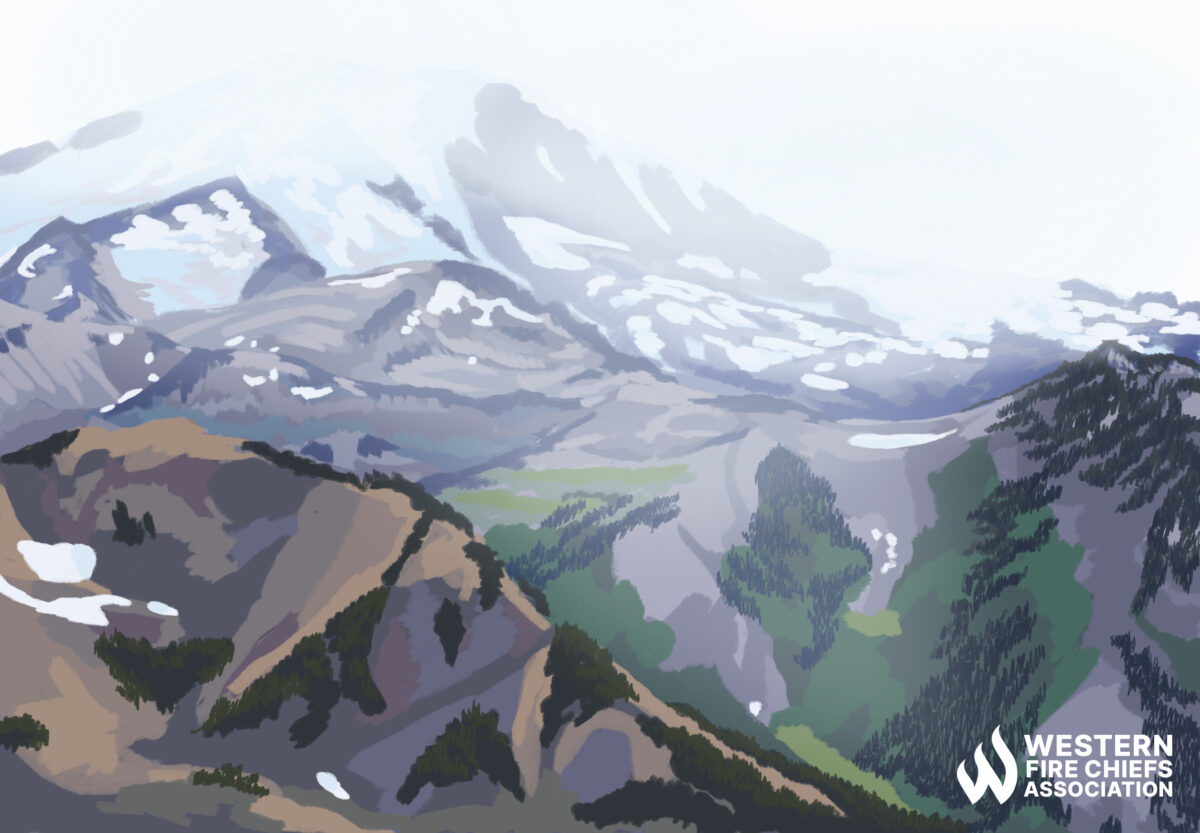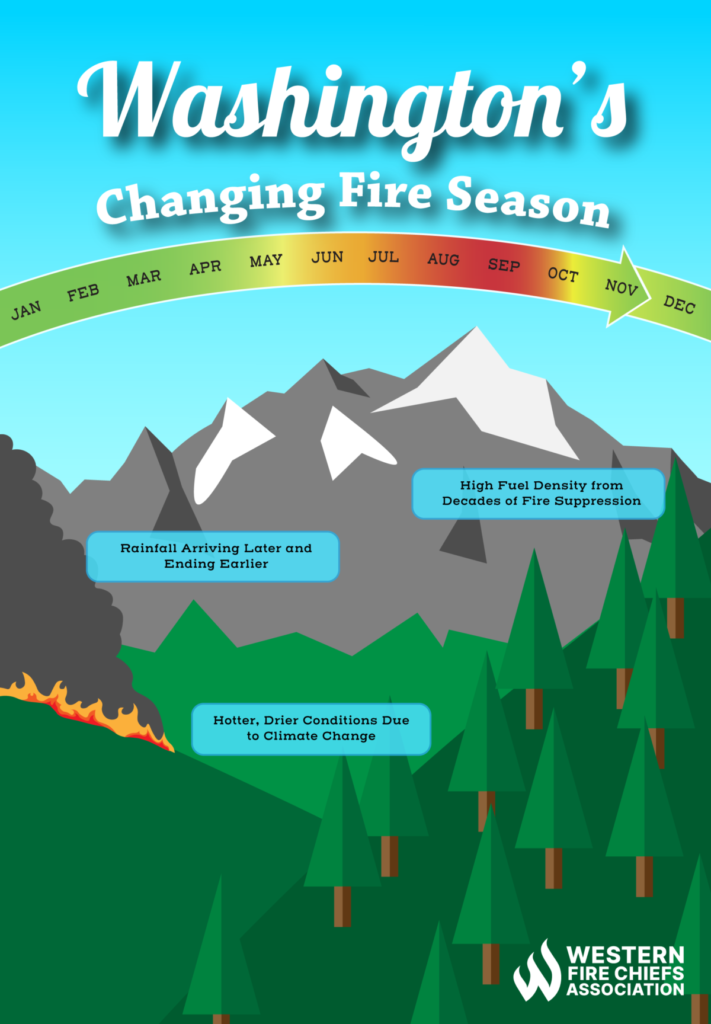Fire Pit Safety Tips
Stay safe around the campfire with tips from the Western Fire Chiefs Association. Learn essential precautions and practices for a worry-free outdoor campfire.
Explore details regarding the Washington fire season from the Western Fire Chiefs Association (WFCA). Learn when is it, how long it lasts, risk factors and more.
Published:March 1, 2023
Edited:April 24, 2024

Explore details regarding the Washington fire season from the Western Fire Chiefs Association (WFCA). Learn when is it, how long it lasts, risk factors and more.
Wildfire season in Washington typically starts in May and ends in October.1 Late rains in spring or early rains in fall can shorten the season. Wildfires can happen any time of the year, depending on weather conditions and human impact.
In a typical year, the Washington Department of Natural Resources (DNR) fights roughly 900 wildland fires across the state, with approximately 70% occurring in Eastern Washington. Most of these wildfires are small, but any wildfire, under the right conditions, can spread to consume hundreds of thousands of acres.2
Climate change is raising temperatures in Washington and reducing humidity throughout the state. This change is expected to extend Washington’s fire season in future years and contribute to increased fire events.3
Long stretches of dry weather and low humidity create conditions where wildfire risk is high. Wildfires often start when lightning strikes dry grass in rangeland. High winds spread wildfire faster and can contribute to the dry conditions that make wildfire risk even higher.
Nearly 90% of wildfires are started by humans. Four common reasons for wildfire ignition include: unattended campfires, fallen power lines, sparks from dragging materials on cars or trailers, and vehicle crashes. To reduce these risks, Washington residents and visitors are prohibited from using fireworks, incendiary/tracer ammunition, and exploding targets during fire season, and are asked to carry fire extinguishing supplies and maintain their vehicles and trailers to prevent sparks.1
Historically, Washington’s Indigenous peoples maintained forested areas with regular burns to clear vegetation, build drought-resistant forests, and prevent insect and pest outbreaks. Wildfires ignited by lightning also cleared flammable debris from areas throughout the state at regular intervals during the year.
Wildfire suppression between 1950-2000 led to overgrown forests and wildland and increasing wildfire intensity in Washington state. Recently, large areas of Washington have been significantly affected by a fire. The total area burned between 2000-2020 (5.6 million acres over 20 years)5 is more typical of historical fire regimes, though many of these wildfires were not as controlled as the prescribed burns that keep Washington’s wildland clear of fuel buildup.6

The largest single fire in Washington during the 21st century was the Carlton Complex Fire. The fire was started in 2014 by lightning strikes in North Central Washington’s Okanogan County, and it burned 256,108 acres.7
Recent simultaneous wildfires, called complex fires when they burn close together, have collectively surpassed this level of devastation and strongly affected Washington’s forests, rangeland, air quality, and communities throughout the Pacific Northwest. Below is a list of recent major wildfires in Washington State.
| Nakia Creek Fire (2022)8 Start Date: 10/9/2022 Location: Clark County Acres Burned: 1,918 Cause: Human (under investigation) | Bolt Creek Fire (2022)9 Start Date: 9/10/2022 Location: King County Acres Burned: 14,766 Cause: Human (under investigation) |
| Schneider Springs Fire (2021)10 Start Date: 8/4/2021 Location: Yakima County Acres Burned: 107,322 Cause: Lightning | Lick Creek (Dry Gulch) Fire (2021)11 Start Date: 7/7/2021 Location: Lincoln County Acres Burned: 80,421 Cause: Lightning |
| Whitney Fire (2020) Start Date: 9/7/2020 Location: Lincoln County Acres Burned: 127,430 Cause: Human (downed power lines) | Labor Day Fires (including Cold Springs Canyon and Pearl Hill fires) (2020) Start Date: 9/7/2020 Location: Okanogan/Douglas Counties Acres Burned: 413,835 Cause: Human (downed power lines) |
| Williams Flats Fire (2019) Start Date: 8/2/2019 Location: Ferry County Acres Burned: 44,378 Cause: Lightning | Grass Valley Fire (2018) Start Date: 8/11/2018 Location: Douglas County Acres Burned: 76,868 Cause: Unknown |
| Boylston Fire (2018) Start Date: 7/19/2018 Location: Yakima County Acres Burned: 71,694 Cause: Human | Norse Peak Fire (2017)12 Start Date: 8/11/2017 Location: Yakima County Acres Burned: 52,062 Cause: Lightning |
| Diamond Creek Fire (2017) Start Date: 7/23/2017 Location: Okanogan County Acres Burned: 127,785 Cause: Human (improperly extinguished campfire) | Range 12 Fire (2016) Start Date: 7/30/2016 Location: Yakima County Acres Burned: 177,210 Cause: Human (Army training exercise with live tracer rounds) |
| Okanogan Complex Fire (2015) Start Date: 8/15/2015 Location: Okanogan County Acres Burned: 304,782 Cause: Five separate wildfires caused by lightning strikes |
Washington forests have seen combustible fuel dramatically increase due to wildfire restrictions between 1950 and 2000. Many state organizations and researchers, including Washington’s DNR, are now working to employ wildfire mitigation strategies.3
Some tactics they use include:
State legislation in 2021 funded upgrades to Washington’s wildfire response. Newly purchased equipment included 16 bulldozers, four excavators, and two airplanes. The Kodiak multi-mission planes replaced Washington’s previous firefighting and scouting aircraft, which were Vietnam War-era helicopters.3
Washington receives wildfire protection services and firefighting from federal, state, county, city, and private agencies, and private timber companies.2 In previous years, the DNR had roughly 40 full-time firefighters, but was able to support 100 additional full-time firefighters in 2022.13
Updated fire equipment and speedier response times, as well as crucial forest health programs, have decreased the impact of recent fire seasons in Washington. Residents can do their part to help prevent wildfires and to protect their homes from fire by staying informed about Washington’s burn bans, current wildfires in their area, and fire safety practices.
Utilize WFCA’s Fire Map to search for the status of an active wildfire in Washington. Users can zoom in and select each individual fire to get instant access to the latest published information.
Stay safe around the campfire with tips from the Western Fire Chiefs Association. Learn essential precautions and practices for a worry-free outdoor campfire.
Discover essential firework safety tips to ensure a dazzling display without accidents. Learn how to celebrate responsibly with expert guidance from WFCA.
Explore the role of AI in wildfire prediction with guidance from the WFCA. Learn how advanced algorithms and data analytics enhance early detection and response.